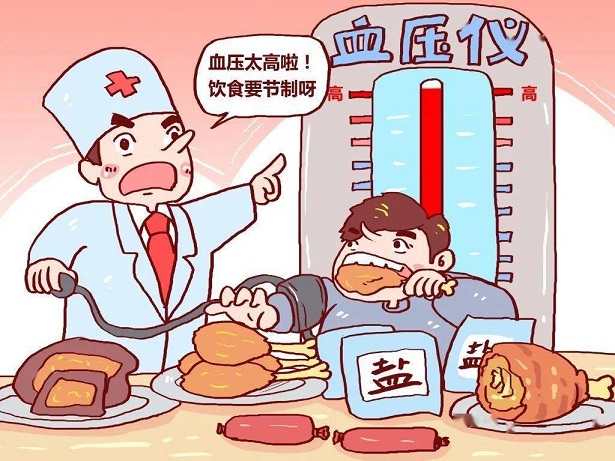SCI论文(www.lunwensci.com):
【摘要】 目的: 观察无盐饮食联合低钠血液透析治疗顽固性高血压患者的效果。方法: 选取 53 例血液透析并发顽固性高血压患者 作为研究对象, 均给予无盐饮食联合低钠血液透析, 分析血液透析 4 个月后患者的血压、增加体重、血钠变化, 以及生命质量和营养状况。 结果: 无盐饮食联合低钠透析 1 周后平均收缩压和平均舒张压均逐渐下降,2 个月后趋于稳定;无盐饮食联合低钠透析开始后增加体重与 血钠逐渐下降,2 个月后趋于稳定;无盐饮食联合低钠透析 1 个月后,社会功能评分下降,2 个月后升高,3 个月后趋于稳定;生理机能 评分逐渐升高, 3 个月后趋于稳定;无盐饮食联合低钠透析后进食量、胃肠道症状评分升高, 1 个月后进食量评分下降, 2 个月后趋于稳定, 1 个月后胃肠道症状评分降低,3 个月后趋于稳定。结论: 无盐饮食联合低钠透析对血液透析顽固性高血压患者有明显的降压作用,因饮 食习惯改变在开始的 1~2 个月内对生命质量和营养状况个别领域有一定影响,但总体上生命质量有改善,营养状况稳定。
【关键词】 低钠血液透析;顽固性高血压;无盐饮食;生命质量;营养状况
Effects of salt-free diet combined with low-sodium hemodialysis in treatment of patients with refractory hypertension
BIE Xin1, ZHANG Yimin2, MA Zudeng3*
(1. Humen Hospital of Traditional Chinese Medicine, Dongguan 523899 Guangdong , China;
2. The Sixth Affiliated Hospital of Sun Yat-sen University, Guangzhou 510655 Guangdong, China;
3. Shenzhen Hospital of Integrated Traditional Chinese and Western Medicine, Shenzhen 518104 Guangdong, China)
【Abstract 】 Objective: To observe effects of salt-free diet combined with low-sodium hemodialysis in treatment of patients with refractory hypertension.Methods: 53 cases of hemodialysis patients were selected as the research objects.All patients were given salt-free diet combined with low-sodium hemodialysis.4 months after hemodialysis, the blood pressure levels, the weight gains, the blood sodium changes, the quality of life and the nutritional status comprehensive evaluation results were analyzed.Results: After 1 week of salt-free diet combined with low-sodium dialysis, the average systolic blood pressure and diastolic blood pressure gradually decreased, and stabilized 2 months later.After the salt-free diet combined with low-sodium dialysis started, the dry weight and the blood sodium level gradually decreased, and stabilized 2 months later.After salt-free diet combined with low-sodium dialysis started, the social function score decreased, increased 2 months later, and stabilized 3 months later; the physiological function score gradually increased, and stabilized 3 months later.After salt-free diet combined with low-sodium dialysis started, the food intake and the gastrointestinal symptoms score increased; the food intake score decreased 1 month later, and stabilized months later; the gastrointestinal symptoms score decreased 1 month later, and stabilized 3 months later.Conclusions: The salt-free diet combined with low-sodium dialysis can significantly reduce the blood pressure levels in the patients with refractory hypertension on hemodialysis.It has a certain influence on the quality of life and nutritional status 1-2 months after application of the salt-free diet combined with low-sodium dialysis, but overall the quality of life has improved and the nutritional status is stable .
【Key words】 Hemodialysis; Refractory hypertension; Salt-free diet; Quality of life; Nutritional status
高血压是维持性血液透析患者最常见的伴发病 之一,2/3 以上的患者持续存在高血压 [1-2] 。血液透析患者常合并顽固性高血压,限制食盐摄入量后,部分血液透析患者控制血压效果仍不佳 [3]。本文观 察无盐饮食和低钠透析治疗血液透析顽固性高血压 患者的效果。
1 资料与方法
1.1 一般资料 选取 2018 年 7 月至 2020 年 6 月 深圳市中西医结合医院收治的 53 例血液透析伴顽 固性高血压患者作为研究对象。纳入标准:心功能Ⅱ级以上;无发热、咳嗽等感染表现;血红蛋白≥ 90 g/L, 白蛋 白 ≥ 40 g/L; 口服苯磺酸氨氯地平 5 mg/d+ 贝那普利 10 mg/d 后动态血压检测平均收缩 压≥ 170 mmHg 或平均舒张压≥ 110 mmHg。排除 标准:有心脑血管病史者;存在严重感染者;中途 退出研究者。其中男 49 例,女 4 例;慢性肾炎 23 例,糖尿病肾病 21 例,高血压肾病 4 例,急进性 肾炎 1 例,狼疮性肾炎 1 例,痛风性肾病 1 例,多 囊肾病 1 例,其他 1 例。
1.2 方法 无盐饮食:首先对患者进行食物选择、 烹制示范和培训,主食为米、面,不加食盐也无含 盐馅类。烹调蔬菜、肉、鱼、蛋类以及汤类均不放 入食盐(包括酱油和食醋)。可摄入适量辣椒、葱、 蒜、姜刺激食欲。低钠透析:每周血液透析 2~3 次, 每次 4 h。 使用金宝 AK-96 型透析机,通过调节电导度使透 析液钠浓度在 132~135 mmol/L。个别不能坚持全 程低钠透析者,行可调钠透析,但透析液钠浓度 135 mmol/L 以下持续时间不短于 1 h。
1.3 观察指标 (1)管理 4 个月后血压水平变化。(2)管理4个月后增加体重与血钠变化。增加体重 = 透析 48 h 后体重 - 干体重。(3)管理 4 个月后生 命质量。采用 SF-36 问卷调查评估, 包括生理机能、 生理职能、躯体疼痛、一般健康状况、精力、社会 功能、情感职能、精神健康等方面,每个方面 100 分,分数越高,生命质量越好。(4)管理 4 个月 后营养状况综合评估结果。采用营养不良炎症评分 (MIS)评估,包括 10 个部分,评分标准按照从优 到劣每项 0~3 分计算,总分 30 分,<8 分为轻度营 养不良,9~18 分为中度营养不良,>18 分为重度营 养不良。
1.4 统计学方法 应用 SPSS 21.0 软件进行统计学 分析,计量资料以( ±s )表示,采用 t 检验,计 数资料以率(%)表示,采用 χ2 检验,以 P<0.05 为差异有统计学意义。
2 结果
2.1 管理 4 个月后血压水平变化 无盐饮食联合 低钠透析 1 周后平均收缩压和平均舒张压均逐渐下 降,2 个月后趋于稳定。见表 1。
2.2 管理 4 个月后增加体重与血钠变化 无盐饮 食联合低钠透析开始后增加体重与血钠逐渐下降,2 个月后趋于稳定。见表 2。
2.3 管理 4 个月后生命质量变化 无盐饮食联合 低钠透析 1 个月后,患者社会功能评分下降,2 个 月后升高,3 个月后趋于稳定;生理机能评分逐渐 升高,3 个月后趋于稳定。见表 3。
2.4 炎症营养状况综合评估结果 无盐饮食联合 低钠透析后进食量、胃肠道症状评分升高,1 个月 后进食量评分下降,2 个月后趋于稳定,1 个月后 胃肠道症状评分降低,3 个月后趋于稳定。见表 4。
3 讨论
尿毒症患者肾脏排钠能力下降,导致钠缓慢在 体内聚集,引发顽固性高血压 [4] 。通过延长透析时 间降低血液透析患者的高血压有一定疗效,然而增 加透析频次或延长透析时间必将伴随医疗费用增加 和医疗资源进一步占用,可行性大打折扣。通过向 血液透析患者提供营养咨询指导, 减少食盐摄入量, 对控制血压具有一定效果,但对于清除体内聚集钠 作用有限, 短时间内难以实现血压平稳有效下降[5-6]。 血液透析患者干体重维持稳定至关重要,若持续下 降标志患者营养状况逐渐变差 [7]。对于存在顽固性 高血压的血液透析患者,血钠维持在偏低水平有利 于血压控制,若血钠持续下降最终影响患者的生理 功能甚至生命 [8]。
本研究结果显示,无盐饮食联合低钠透析 1 周后平均收缩压、平均舒张压、增加体重与血钠逐 渐下降,2 个月后趋于稳定。分析原因在于,无盐 饮食联合低钠透析有利于尽快清除多余钠,使细 胞内外钠尽快恢复正常分布和水平 [9]。血容量增加 及波动是血液透析患者血压升高的重要原因,对 于容量依赖性高血压患者,如果肾功能正常可以 口服利尿剂排钠以降低血容量,从而产生降压作 用,但是肾衰竭患者尿量减少或无尿,排钠利尿剂 无效或几乎无效,其他各类扩血管降压药物作用较 差 [10-11] 。透析后脱水增加,引起交感神经兴奋,缩 血管物质释放增加,也参与高血压的形成,此外, 钠摄入量与血压高低存在因果关系,无盐饮食和低 钠透析持续一定时间后,血钠逐渐下降,处于正常 低值 [12-13] 。血管内皮细胞钠减少,交感神经释放的 神经冲动反应性下降,同时交感神经兴奋性下降, 血管收缩作用减弱,对降血压药物的反应增强 [14]。
本研究结果同时显示,无盐饮食联合低钠透析 1 个月后,社会功能评分下降,2 个月后升高,3 个月后趋于稳定;生理机能评分逐渐升高,3 个月 后趋于稳定;进食量、胃肠道症状评分升高,1 个 月后进食量评分下降,2 个月后趋于稳定,1 个月后胃肠道症状评分降低,3 个月后趋于稳定。分析 原因在于,首先患者担心参加亲友、社会聚餐影响 无盐饮食,给别人和自己带来不便,后续通过调整自己参加聚餐习惯、另外指定烹调方法等适应无盐 饮食要求,第 3 个月社会功能领域评分恢复,生命 质量改善 [15] 。无盐饮食联合低钠透析第 1、2 个月 影响患者食欲和胃肠道症状,患者自感口淡无味, 饮食习惯发生了改变,刺激食欲的盐味没有了,摄 食量减少,甚至出现腹胀不适等胃肠道症状。需要 适当增加辣味或其他方式刺激食欲, 改变饮食习惯。 患者总体营养评分没有改变,可见,无盐饮食并没 有影响患者的总体营养状况。随着对无盐饮食的适 应,食欲恢复、胃肠道症状缓解,在透析之初的一 定时间内营养状况总体上有一定改善 [16]。
综上所述,无盐饮食联合低钠透析对血液透析 顽固性高血压患者有明显的降压作用,因饮食习惯 改变在开始的 1~2 个月对生命质量和营养状况个别 领域有一定影响,但总体上生命质量有改善,营养 状况稳定。
参考文献
[1] Ok E ,Asci G ,Chazot C ,et al. Controversies and problems of volume control and hypertension in haemodialysis[J]. Lancet, 2016,388(10041): 285-293.
[2] 中国人民解放军肾病专业协作组 . 2001 例血液透析患者病因 分析及高血压和贫血治疗现状 [J]. 中国血液净化,2005,4 (5):235-238.
[3] Santi XP,Perez VB,Cuadrado ML,et al. Total body water and failure to control blood pressure by medication in hemodialysis patients[J]. Nephron Extra, 2014,4(2):95-100
[4] Van Buren PN, Inrig JK. Hypertension and hemodialysis: pathophysiology and outcome in adult and pediatric population[J]. Pediatr Nephrol,2012,27(3):339-350.
[5] Boyle SM, Berns JS. Erythropoietin and resistant hypertension in CKD[J]. Nephrol,2014,34(5):540-549.
[6] Kotanko P,Garg AX ,Depner T ,et al. Effects of Frequent Hemodialysis on Blood Pressure:Results from the Randomized Frequent Hemodialysis Network Trials[J]. Hemodial Int, 2015, 19 (3):386-401
[7] Rivara BR,Adams SV, Kuttykrishnan S, et al. Extended-hours hemodialysis is associated with lower mortality risk in patients with end-stage renal disease[J]. Kidney Int,2016,90(6): 1312-1320.
[8] Sakai A,Hamada H,Hara K, et al. Nutritional counseling regulates interdialytic weight gain and blood pressure in outpatients receiving maintenance hemodialysis[J]. J Med Invest,2017,64 (1):129-135.
[9] Shimosawa T. Salt,the rennin angiotensin aldosterone system and resistant hypertension[J]. Hypertens Res,2013,36(8):657-660.
[10] Agarwal R, Sinha AD. Thiazide diuretics in advanced chronic kidney disease[J]. J Am Soc Hypertens,2012,6(5):299-308.
[11] Machnik A ,Neuhofer W ,Jantsch J ,et al . Macrophages regulate salt-dependent volume and blood pressure by a vascular endothelial growth factor-C-dependent[J]. Nat Med, 2009,15(5):545-552.
[12] Haddy FJ. Role of dietary salt in hypertension[J]. Life Sci, 2006, 79(17):1585-1592.
[13] de Beus E, de Jager RL, Beeftink MM,et al. Salt intake and blood pressure response to percutaneous renal denervation in resistant hypertension[J]. J Clin Hypertens (Greenwich), 2017, 19(11):1125-1133.
[14] Adrogué HJ , Madias NE. Sodium and potassium in the pathogenesis of hypertension: focus on the brain. Curr Opin Nephrol Hypertens[J],2017,26(2):106-113.
[15] Bagheri Z ,Jafari P ,Faghih M ,et al. Testing measurement equivalence of the SF-36 questionnaire across patients on hemodialysis and healthy people[J]. Int Urol Nephrol,2015,47(12):2013-2021.
[16] Silva LF ,Lopes GB ,Matos CM ,et al . Gastrointestinal symptoms and nutritional status in women and men on maintenance hemodialysis[J]. J Ren Nutr, 2012,22(3):327-335.
关注SCI论文创作发表,寻求SCI论文修改润色、SCI论文代发表等服务支撑,请锁定SCI论文网!
文章出自SCI论文网转载请注明出处:https://www.lunwensci.com/yixuelunwen/33749.html



